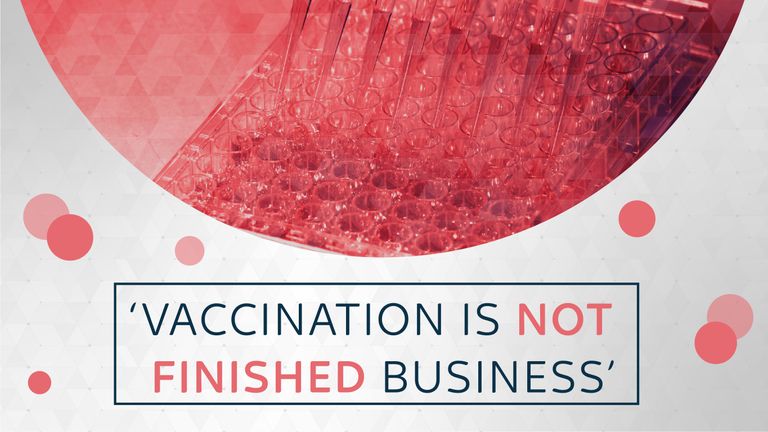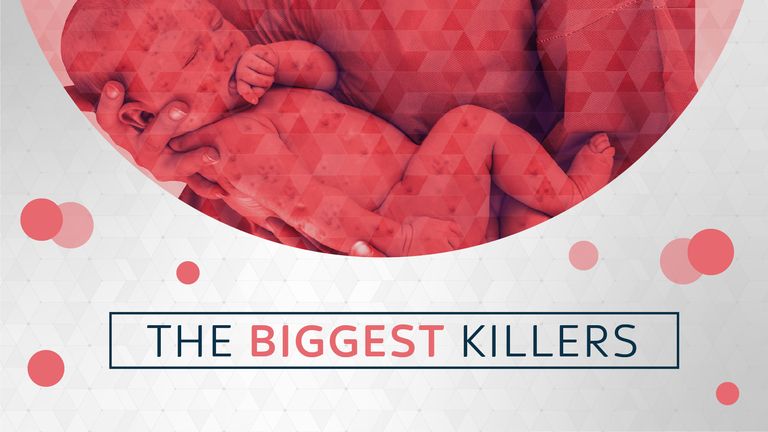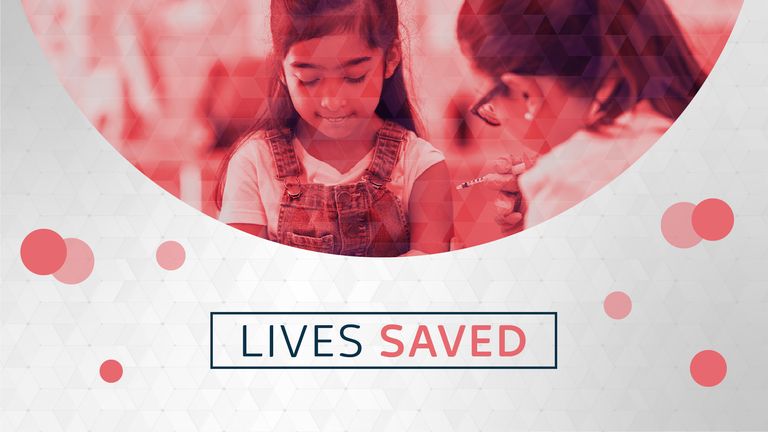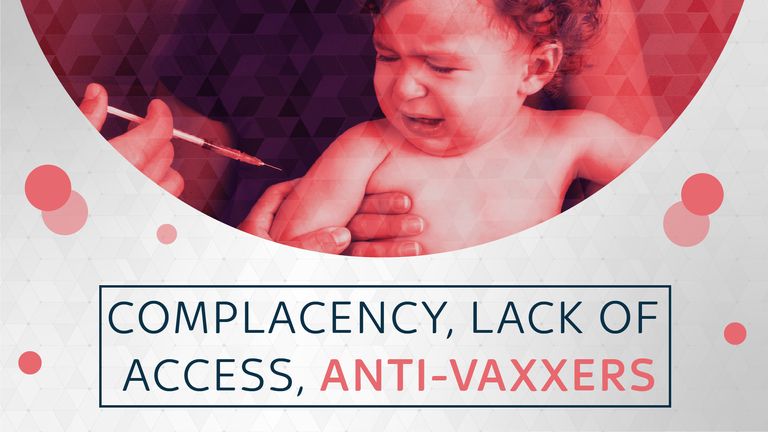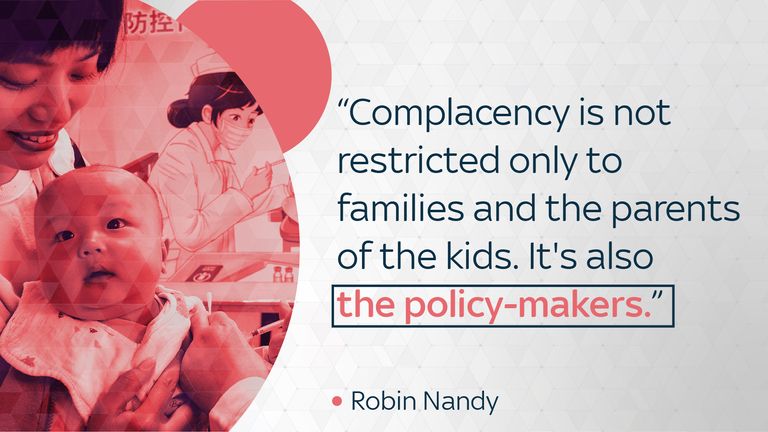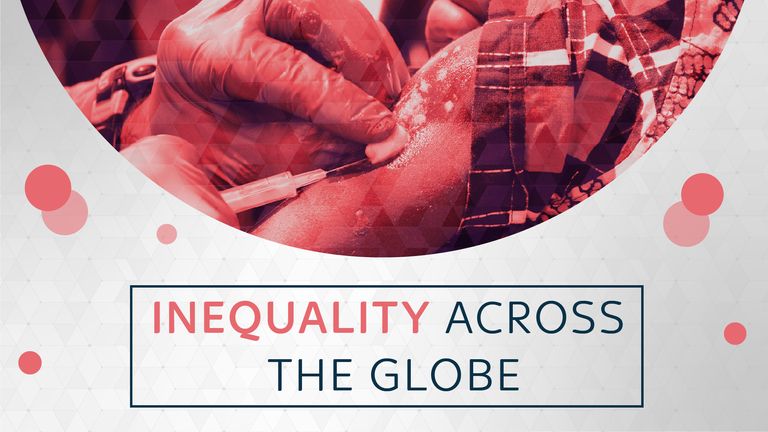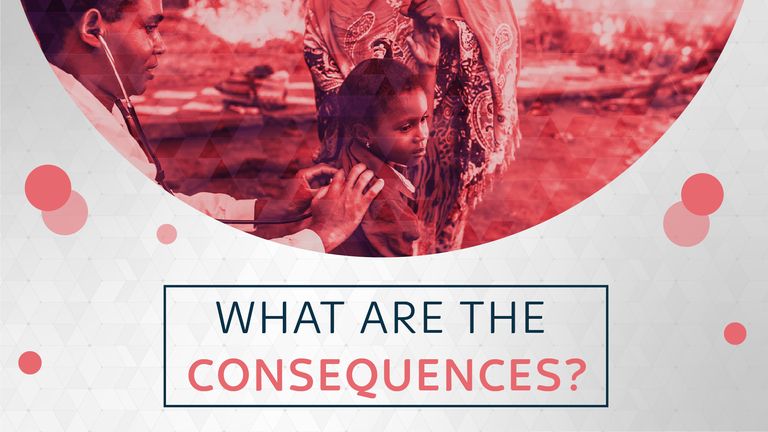Why 7,000 people die needlessly every day
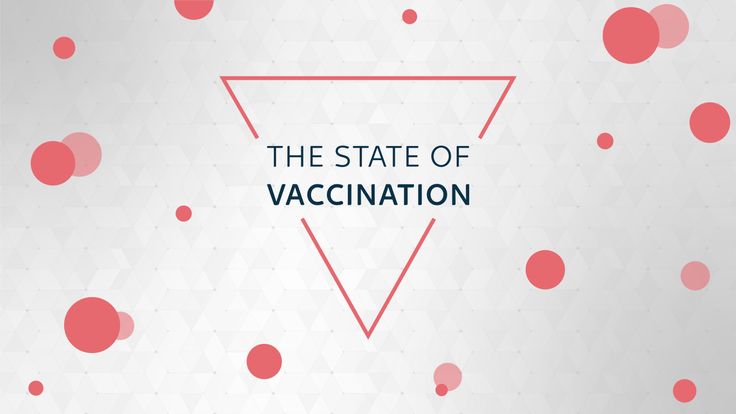
Thursday 29 August 2019 12:45, UK
By Carmen Aguilar García, data journalist and Philip Whiteside, international news reporter
The number of people dying from diseases which could be prevented by vaccines has fallen across the globe over the past 30 years. But a toxic mix of misinformation, mistrust among anti-vaxxer groups and difficulty in reaching potential victims is holding up hopes of eradicating them altogether.
The figures, though improving, remain staggering: more than 2.6 million died from the diseases in 2017, the last full year for which figures are available.
Children under the age of five, often in underdeveloped nations, are frequently the victims.
Analysis gathered exclusively by Sky News tells a complex story. And, while much progress has been made, the struggle to reach remote corners of the globe and fight disinformation about vaccine-preventable diseases (VPDs) continues.
Robin Nandy, Principal Adviser and Chief of Immunisation for UNICEF, says: "Ten, 20 years ago, I could not have expected us to be in this situation where we are today, with multiple outbreaks of measles in all different types of countries: You're seeing them in high-income countries like in Britain.
"You're seeing them in middle-income countries... low-income countries."
"If we take our foot off the pedal, things can regress pretty quickly. It's really important to drill the message home," he added.
"Vaccination is not finished business.
"As long as children keep getting born in the world, we need to continue to vaccinate."
Sky News has carried out exclusive analysis of data from international agencies. The figures, from the Global Burden of Disease Study, coordinated by the Institute of Health Metrics and Evaluation, tell a sad story.
After pneumococcal pneumonia, which kills 15 in every 100,000, the main cause of death is rotavirus - a gastric viral infection that causes severe diarrhoea, vomiting and dehydration.
The disease, which kills four in every 100,000, is extremely common: experts believe almost every child in the world gets infected at least once by the time they are five. Most of those who die are children killed by dehydration.
In developed countries, deaths are rare because access to healthcare is widespread, but in African countries deaths are still common.
But there is a vaccine that can protect against it - one said to be capable of preventing up to a third of all diarrhoea across the developing world.
The third biggest killer is cervical cancer, which in 2017 killed 260,000 people worldwide, according to the Global Burden of Disease study (GBD), which is 3.4 out of every 100,000. While death rates of many VPDs have fallen, the number dying from cervical cancer has barely changed.
More than 90% of cases are caused by the human papillomavirus (HPV) - a sexually transmitted virus also said to be responsible for between 40% and 90% of head, neck and genital cancers.
Most carriers do not become ill, but can spread it to others. The HPV vaccine has proved highly effective at preventing these cancers.
The main agencies which work to promote vaccination say they have been highly successful at saving lives in the last few years.
GAVI, which was started at the World Economic Forum to bring innovations in vaccination to the developing world, says it has immunised 700 million children and prevented 10 million deaths in low-income countries since it was set up in 2000.
UNICEF, the UN's children's agency, which is the largest procurer and supplier of vaccines to developing and low-middle income countries, says it has increased the range of vaccines that youngsters in many countries receive from six to as many as 16.
But, without exception, all the organisations tasked with reducing the impact of VPDs say their job is becoming harder.
The evidence shows that as more and more children and adults are vaccinated, more lives are saved.
It may be impossible to reach 100% coverage but health authorities say that is not the aim.
At 80-95% coverage, depending on how contagious a disease is, something called "herd immunity" kicks in - a level at which so few people are able to get a disease that it is unable to go from person to person.
When that happens, a disease dies.
It has happened already: In 1980, the UN heath agency WHO declared: "Smallpox is dead!".
It came after the agency in 1967 had begun a worldwide campaign to eradicate the disease, which throughout the 20th century was estimated to have killed 300 million people.
Developed nations started introducing vaccines in the early to mid-20th century, but it wasn't until the 1970s that the WHO rolled out a worldwide vaccination scheme, called Expanded Programme on Immunisation (EPI), to "ensure that all children in all countries benefited from life-saving vaccines".
The first diseases targeted by the programme were diphtheria, whooping cough (pertussis), tetanus, measles, poliomyelitis (polio) and tuberculosis (TB).
WHO now recommends routine vaccination against 15 diseases, with hepatitis B, haemophilus influenzae type b (Hib, also known as bacterial influenza), human papillomavirus (HPV), seasonal influenza, mumps, rubella, pneumococcal disease, rotavirus, and varicella now also included.
A number of other vaccinations are recommended for people travelling to areas where diseases are endemic.
Countries like the UK choose to vaccinate against some of those diseases, for example meningococcal group B bacteria, which can cause meningitis.
Overall, worldwide coverage has increased in all recommended WHO vaccines since the 1980s. Now at least a quarter of the world's population receives doses of almost all the WHO 15 routinely recommended vaccines.
Vaccines like DTP1 (a single dose of a combination vaccine to prevent diphtheria, tetanus and whooping cough) achieved 85% coverage as early as 1990.
Currently, 85% of the world's children receive three doses of the DTP vaccine.
But there's a problem. That 85% rate of coverage has barely changed in the last decade, and there are many others vaccines that are newer and are yet to be widely distributed. For the disease to be wiped out, coverage needs to be pushed closer to the 95% threshold.
Mr Nandy said: "What happened is that the proverbial 'low hanging fruit' has been exhausted.
"All the children that are relatively easy to reach, have been reached. The remaining 15 or so percent are much harder to reach.
"We've done analysis of where the unvaccinated kids are and we increasingly see them either in remote rural populations with no access to health services, or in conflict-affected, insecure, areas where, again, there is an access barrier. People can't travel to health facilities, even if they exist."
Many vaccines have rapidly been adopted. For example, the third dose of Hepatitis B is now given to 84% of the world's children, having only been provided to 18% of youngsters in 1999.
But UNICEF and GAVI have been doing a huge amount of work to reach children in hard-to-reach areas.
Mr Nandy told Sky News that ways to increase immunisation includes linking it to birth registration; adjust delivery schedules to provide evening or weekend vaccination; linking it up with other services such as deworming or diarrhoea treatment.
The problem is that for every extra child who is now reached, it appears as though other children are missing out because of a trend in more developed countries to not vaccinate.
Experts say there are a range of reasons youngsters are not receiving potentially life-saving inoculations.
Seth Berkley, CEO of GAVI, told Sky News: "In wealthy countries there is a sense of complacency that has set in, enflamed of course by the nefarious forces.
"My wife, for example, is a doctor. She used to run intensive care units and major academic teaching centres and she'd never seen a case of measles, she had never seen a case of tetanus.
"So there is a sense (even among the medical community) that these diseases don't exist anymore, they're not a problem. And that space allows people to begin to question.
"We've seen less of that and in poor countries because they still see the diseases. But of course it's one big world now and with the Internet we're seeing these spill over globally."
Dr Nandy says it's not just the medical profession, there is also a lack of urgency among politicians.
He adds: "People are busy; they have to make choices about how they spend their time and spending an hour or two at a health facility seeking vaccines may not be high on the radar, particularly if you're not seeing that these diseases anymore.
"Complacency is not restricted only to families and the parents of the kids. It's also… the policy- makers, the folks who are allocating financing for things like immunisation, because there's a feeling that the job is done now."
Fanning in the flames in many Western countries has been the anti-vax movement.
Much of the scepticism around vaccination stems from a discredited study by British surgeon Andrew Wakefield that erroneously linked autism to the MMR vaccine. That study has been retracted, and nine years ago Wakefield was struck off the UK medical registry.
But in the age of fake news, the claims proliferate on the internet, frightening thousands of parents into preventing their children from receiving their jabs, especially in countries like Italy.
And Wakefield himself has continued to espouse his claims, directing a film in 2016 attacking the US Centers for Disease Control and Prevention (CDC).
Dr Berkley says: "There are people who are actively trying to pass this information around.
"And that creates confusion and it affects the trust in government and in institutions and that trust is absolutely critical because, in any country, if you have a child that's going to get sick - one child will get sick the day before a vaccine and another'll get sick the day after - you have to have trust that it's not a problem of that vaccine. And that requires a level of confidence in governments or doctors or in research institutions."
"If you start losing that then it really begins to take the wheels off the bus."
Aggravating the problem, he said, were makers and retailers of "alternative" health products, using the web to advertise their "medicines" in an attempt to gain from people who avoid vaccination.
Despite the number of people dying from VPDs falling over the last 20 years, large numbers are still losing their lives to diseases in less developed countries.
Dr Nandy says: "It's very important to remember that (the) 85% global coverage (of the proxy vaccine DTP3) masks a lot of inequities. There is huge variation across countries.
"If you look at a country like Nigeria, the national coverage is between 40 and 50%.
"But if you go into (it at state level)… there are some states with 20%.
"It's not the (remaining) 15% that we are trying to reach across the board. It's these pockets of unvaccinated (people), which we need to reach, that present the highest risk of outbreak."
He said among the greatest challenges was vaccinating children in countries like Syria, Yemen, Somalia and South Sudan, where, because of conflict "health facilities either get attacked or disrupted".
The first vaccine (for smallpox) was pioneered in the 18th century by British physician Edward Jenner, who worked out that if you infect someone with cowpox, they would not derive a disease.
Since Dr Jenner's invention, vaccines have been developed for many of the world's other big killer viruses.
MEASLES
Late in 2018, WHO announced that measles cases had spiked the year before in multiple countries as a result of gaps in vaccination coverage.
Because of those gaps, WHO estimated 110,000 people had died in 2017.
Dr Soumya Swaminathan, Deputy Director General for Programmes at WHO, said urgent action was required to plug those gaps or it would undo "decades of progress in protecting children… against (an)… entirely preventable disease".
In the same year, the European Centre for Disease Prevention and Control said measles cases had trebled across the EU in 2017.
In 2018 and 2019, the US has also been suffering outbreaks in at least 28 states, with one centred around the orthodox Jewish community in New York. Measles had previously been declared eliminated in the US in 2000.
Numerous other outbreaks have occurred across the world in the last 10 years.
Among them is Venezuela. In the early part of the century, the whole of South America was considered measles-free. Now the CDC says the resurgence of measles in Venezuela is a "regional public health threat in the (whole of the) Americas".
POLIO
Meanwhile, because of conflict and displaced communities, polio has remained endemic in Afghanistan, Pakistan and Nigeria, despite massive efforts to make the disease the world's second to be eradicated.
But, again due to complacency, a new form of polio - said to be caused by live vaccines mutating and infecting people who have remained unvaccinated - has emerged.
In 2017, 96 people were affected by this new form of polio, and 99 in 2018, according to WHO.
WHOOPING COUGH
Around the world, whooping cough remains a big killer in infants, causing 13 deaths per 100,000 children under five.
Also called pertussis, it's a bacterial infection that causes violent, uncontrollable coughing, that causes some people to 'whoop' as they struggle to breath during a bout.
A vaccine was developed as far back as the 1930s, and is now included in the widely available DTP immunisation programme, so many have questioned why whooping cough has not been eliminated, like smallpox.
Babies are particularly vulnerable as they are sometimes unable to breathe, and can die.
TYPHOID
Many people who have been on holiday to developing countries will know how easy it is to be inoculated against Typhoid. The Vi vaccine, which can be given to children aged 2 and over, is available at any GP and lasts 3 years.
The bacterial infection is generally ingested through food and spreads quickly, causing a fever and often diarrhoea. Without treatment, up to one in three cases are fatal, according to the CDC.
But, despite it being easily available in the West, vaccine coverage around the parts of the globe where the disease is endemic, millions of people are thought to be missing out.
The vaccine is now recommended in endemic countries and GAVI is beginning a programme of funding to support its rollout, but it will take some time before the disease is brought under control.
OTHER DISEASES
The Democratic Republic of Congo is currently battling an outbreak of Ebola, for which a vaccine has been developed. But, again, because of conflict and its effect on health care, parts of the DRC have been hit by measles, cholera, yellow fever and other vaccine preventable diseases, because not enough people are being vaccinated.
DISEASES THAT DON'T KILL
And, while some agencies have focused on preventing deaths, health authorities are also keen to reduce the overall number of people catching VPDs that don't necessarily kill, as the impact can be hugely beneficial.
Advanced healthcare systems in developed countries mean that few people who catch VPDs die.
But, people with fevers, from diseases like flu or measles, or with diarrhoea, which they might develop if they have rotavirus, can take up a huge amount of resources, even if they are only moderately affected.
A 2016 study by the National Institute for Health Research found that the cost of the 2012-2013 measles outbreak in Merseyside cost at least 20 times what it would have cost to immunise the community affected.
As well as the much-publicised outbreaks of measles, throughout the UK, Europe, the US and the world, there have been regular outbreaks of mumps, rubella and even diphtheria.
WHAT ABOUT TUBERCULOSIS AND MALARIA?
The strongest memory of vaccination most people in Britain have is when they had a needle stuck in their arm at age 14 to inoculate them against tuberculosis (TB).
But today, according to the IHME, tuberculosis should not be considered a vaccine-preventable disease because the BCG vaccine, which is still widely administered around the world, is only effective in some cases.
Jonathan Mosser, a clinical fellow at the IHME, said: "BCG has about 80% efficacy against disseminated childhood tuberculosis, but much poorer efficacy in preventing it in adults later on in life - maybe 20% against adult pulmonary disease and really only in the early years of adulthood."
By contrast, the measles vaccine is estimated to be 95% effective after one dose and 99% after two.
BCG is now only used in many developed countries for high-risk groups.
Dr Mosser said organisations like the Bill Gates Foundation have been spending millions looking for a new vaccine against TB, but it is not expected until the middle of the next decade.
Meanwhile, although a new vaccine has been developed for malaria, that disease too is not yet considered fully vaccine-preventable as trials are yet to be completed.
As well as the continuing efforts to reverse the trend away from vaccination, the future holds many opportunities for saving lives.
The UK government has put tens of millions of pounds into developing new vaccines to fight some of the diseases which have caused ripples of fear around the world.
Currently, work is under way to find a drug that will prevent zika, MERS, plague and a raft of other deadly viruses.
One of the strands of research is working on a vaccine for a disease called chikungunya, a rarely fatal but disabling mosquito-born disease that is currently surging through South America.
Dengue fever, which is at epidemic levels in many parts of the world and for which a vaccine is only just being introduced, remains a major threat.
And trials are also ongoing for diseases like HIV/AIDS and updated versions of existing vaccines that can cope with a much wider range of conditions, like tropical heat.
But, in all these cases, they will only be effective if vaccination rates can be raised to a level where the whole population is protected - something that at the moment seems worryingly far away.
EDITING by Alessandra Rizzo
METHODOLOGY
Sky News analysis has been guided by experts from the Institute for Health Metrics and Evaluation (IHME).
The list of 18 diseases included as vaccine preventable includes 14 diseases which are estimated as "causes" in the Global Burden Disease Study (cervical cancer, yellow fever, rabies, acute hepatitis A, acute hepatitis B, typhoid fever, pneumococcal meningitis, H influenza type B meningitis, meningococcal meningitis, diphtheria, whooping cough, tetanus, measles, varicella and herpes zoster) and four diseases which are considered "etiologies" (rotavirus, H influenza type B, pneumococcal pneumonia, and influenza).
Due to a difference in the estimation process between causes and etiologies, the IHME has made clear there is a potential, relatively small risk of double counting.
Following IHME's advice, Sky News has not included deaths from diseases such as malaria, dengue or Hepatitis E, among the 26 listed by the WHO, as the vaccines are in implementation period or extremely new. The analysis also excludes tuberculosis because BCG vaccine helps prevent severe childhood diseases, but its effectiveness is limited in adults' forms of tuberculosis.
Due to a lack of comparable data for polio, rubella, mumps, cholera and Japanese encephalitis, this analysis does not include them.
All the organisations say any figure underestimates the real number of deaths or cases, due at least in part to obstacles in identifying cases and gathering information in some parts of the world.
